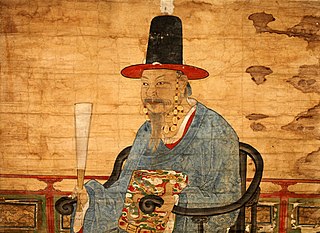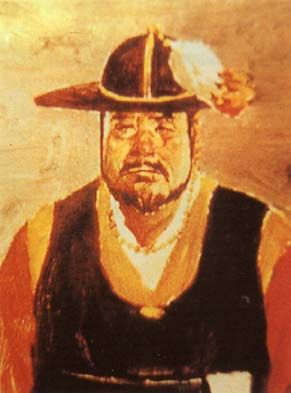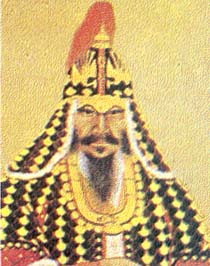
The Japanese invasions of Korea,commonly known as the Imjin War,involved two separate yet linked invasions:an initial invasion in 1592,a brief truce in 1596,and a second invasion in 1597. The conflict ended in 1598 with the withdrawal of Japanese forces from the Korean Peninsula after a military stalemate in Korea's southern provinces.
Righteous armies (Korean: 의병),sometimes translated as irregular armies or militias,were informal civilian militias that appeared several times in Korean history,when the national armies were in need of assistance.

Seonjo,personal name Yi Yeon,was the 14th monarch of the Joseon dynasty of Korea. He was known for promoting Confucianism and attempting reforms at the beginning of his reign. However,he later gained infamy from the political discord and his incompetent leadership during the Japanese invasions of Korea.
The Battle of Chungju or the Battle of Tangeumdae was the last battle of the Chungju Campaign fought between the Koreans and Japanese during the Japanese invasion of Korea in 1592. Chungju is located just south of the Han River and Seoul,Korea's capital. The defeat of the Korean forces at Chungju led directly to the capture of the capital of Hanseong by Japanese forces shortly thereafter.

Won Gyun was a Korean general and admiral during the Joseon period. He is best known for his campaigns against the Japanese during Hideyoshi's invasions of Korea. Won was a member of Wonju Won clan,which was well known for its members' military accomplishments. He was born in 1540 near Pyeongtaek and demonstrated his skill as warrior at a young age. He was qualified as a military officer and was first assigned to the northern border to defend against the Jurchens,who frequently raided Korean villages. Won led many successful campaigns with Yi Il and Yi Sun-sin against the Jurchens. After considerable accomplishments on the northern frontier,he was promoted to admiral in 1592 and sent to the southern coast of Gyeongsang Province to command the province's Western Fleet,along with Yi Sun-sin,who became admiral before Won and took command of Jeolla Province's Eastern Fleet. At the time,Won and Yi were cavalry leaders who had no experience with naval warfare.

The Pukkwan Victory Monument is a stone stele written in Korean Hanmun commemorating a series of Korean military victories between 1592 and 1594 against the invading army of Japan during the Imjin War. First erected in 1707 in Kilju in what is now North Korea,it was subsequently taken to Japan during the Japanese occupation of Korea during the Russo-Japanese War of 1905. It was eventually discovered on the grounds of Yasukuni Shrine in Tokyo,prompting a Korean outcry that it be returned. In a ceremony on 12 October 2005,it was turned over to officials from South Korea,who returned it to its original location,which is now in North Korea.

Gwon Yul was a Korean army general and the commander-in-chief of the Joseon period,who successfully led the Korean forces against Japan during the Japanese invasions of Korea. He is best known for the Battle of Haengju where he defeated an attacking force of about 30,000 Japanese with 2,800 troops.

Kilju,sometimes romanized as Kilchu,is a county in North Hamgyong province,North Korea. The county seat is Kilju Town.

Wonjong of Joseon or Prince Jeongwon was a prince during the Joseon dynasty. He was a son by a concubine to the Joseon dynasty's 14th monarch,king Seonjo,and half brother of king Gwanghaegun and father of king Injo. His birth name was Yi Bu.
Jeong Mun-bu (1565–1624) was a Korean statesman. In 1592,nine days into the Japanese invasion of Korea,he formed a militia to fight against the Japanese army.
Namyang Hong clan is one of the Korean clans. Their Bon-gwan is in Hwaseong,Gyeonggi,Gyeonggi Province. According to the research held in 2015,the number of Namyang Hong clan members was 487,488.
Yi Il was a Korean military official of the mid-Joseon Period. During the reign of Seonjo of Joseon,he made a great contribution to the conquest of the Jurchen people in the north. When Imjin War occurred,he was appointed Mobile Border Commander. He was defeated in Sangju and Chungju but,he contributed to the restoration of Pyongyang.
Kim Chŏn-il was a Korean military leader in the 16th century. He was a Joseon dynasty official and became a righteous army leader during the Imjin war to repel the 1592 Japanese invasion of Korea. He was killed in the second siege of Jinju in 1593.
Imjillok is a historical war story that takes place during the Japanese invasion of Korea in 1592. The story begins with the dream of Emperor Seonjo of Joseon,which foresees Japan’s invasion,proceeds to trace Admiral Yi Sun-shin’s activities as he successfully blocks Japan’s attacks,and concludes with Sa Myeongdang going to Japan and receiving an official document of surrender. While technically based on a true historical event,Imjillok includes a considerable number of fictionalized elements and is ultimately a work created to inspire national pride among the Korean people with regard to Japan.
Yi Jeong-am was a Korean military official of the mid-Joseon Period.
The Battle of Yonan was a confrontation between Joseon "righteous army" forces led by Yi Jeong-am and the 3rd Division of the Japanese Army led by Kuroda Nagamasa in Yonan,Hwanghae Province,Joseon from 3 to 6 October 1592.
Queen Inheon of the Neungseong Gu clan,also known as Lady Gyewoon,was the wife of Grand Internal Prince Jeongwon and the biological mother of King Injo of Joseon.
Deokheung Daewongun,known before as Prince Deokheung before becoming Daewongun,personal name Yi Cho was a royal family member of the Joseon period and the first Daewongun in Korean. He was the second son of Jungjong of Joseon and Royal Noble Consort Chang of the Ansan An clan,also the biological father of Seonjo of Joseon.
Prince Imhae,was a Joseon Royal Prince as the eldest son of King Seonjo and the elder brother of King Gwanghae. He was known for such a violent and arrogant personality,that he murdered some government officials alongside his half brothers:Prince Jeongwon (정원군) and Prince Sunhwa (순화군),but were survived under their father's protection. Also,when his depravity led to government officials demanding severe punishment for his actions,he was able to avoid such punishment by his father's protection too.
Grand Prince Yeongchang,personal name Yi Ui,was a Joseon royal prince as the only legitimate son of King Seonjo,from Queen Inmok who was born when his father was already 55 years old. Due to this,Yeonguijeong Yu Yeong-gyeong (유영경) once tried to select Yeongchang as the Crown Prince to replace his older half-brother,Crown Prince Yi Hon,which eventually caused him to be unjustly executed after Hon's ascension to the throne. People often said that his sad life and death is equivalent to Chang of Goryeo.







